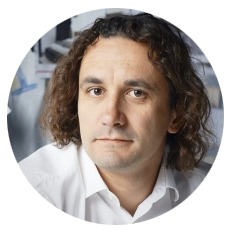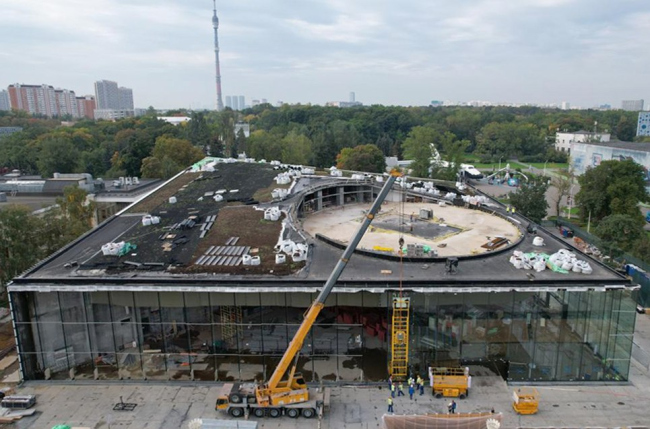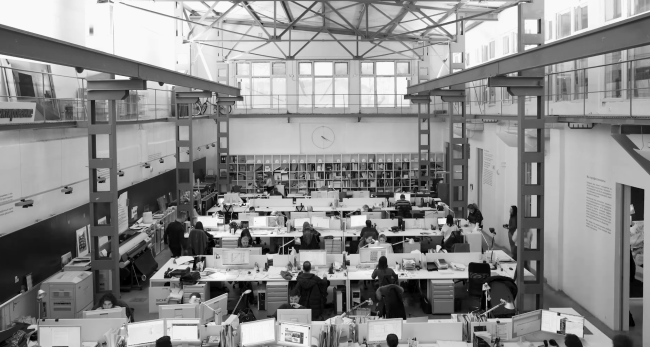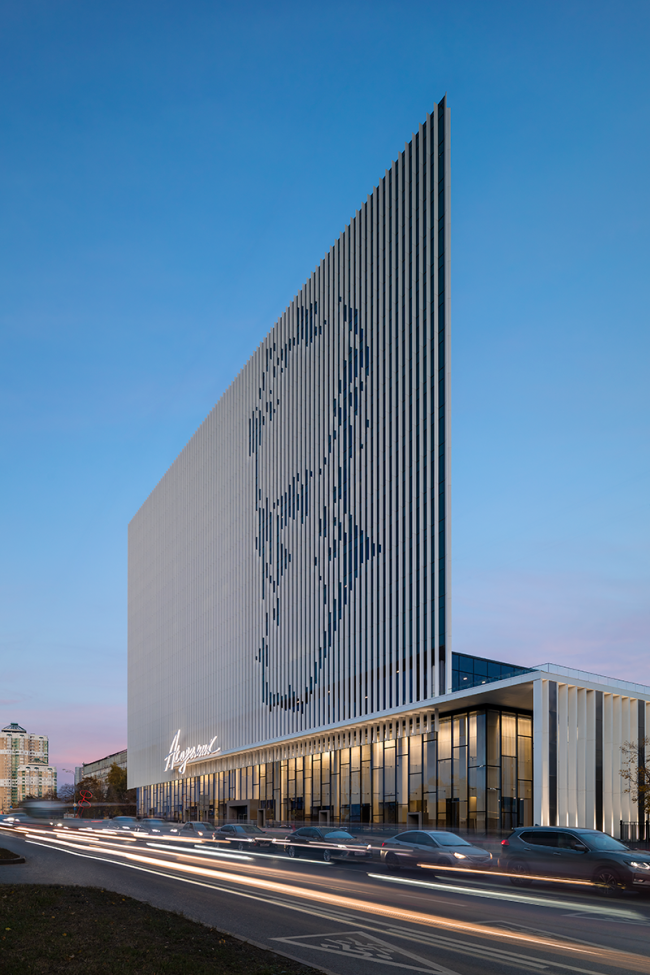|
Published on Archi.ru (https://archi.ru) |
|
| 02.02.2022 | |
|
Yuliy Borisov: “We created a system that is flexible, yet manageable and accumulating competences” |
|
|
Julia Tarabarina |
|
| Architect: | |
| Yuliy Borisov | |
| Studio: | |
| UNK | |
|
UNK has announced a new stage of its reorganization. Now it is an ecosystem consisting of 9 companies interacting with one another “seamlessly and horizontally”. We asked Yuliy Borisov to elaborate on the essence of the reform. According to the press release, UNK is now “a single system, all of whose elements are independent, yet linked to one another”, interacting within “a single seamless environment” aimed at solving various tasks, accompanying the client throughout all the stages of architectural project development, both chronologically – from concept to completion – and scale-wise – from large town-planning tasks to “design elements”. According to Yuliy Borisov, “such a system is, first of all, beneficial for the client, because they get assured quality from the same hands, i.e. integrated and interconnected solutions, thus reducing the time spent on preparing the construction documentation.”  Yuliy Borisov: First of all, the form of ownership. The controlling stake belongs to the parent company UNK. This company handles property issues, manages finances through corporate procedures, manages the HR, and regulates activities within the ecosystem. That’s for starters. Second, an ecosystem is more open; it is focused on increasing the number of its links. It is expected that the divisions will generate new businesses within themselves, and the number of specialized companies will be growing. Currently, we are still developing our structure. OK, currently you are a system of 9 companies, one of which is the head one. How does this correlate with your administrative structure? We have different levels of management. The top level is the board of directors: it includes the heads of all the companies, and it solves strategic issues, such as issues of interconnection of the companies and further adjustment of the structure of their interaction. There is also a level of making tactical decisions, which is delegated to individual companies. Are all the companies located in one place? Today, we have three offices, two of which are located next to each other on the Luzhnetskaya Embankment. We came to this accommodation gradually, and we are still working on its optimization. Of course, the perfect situation would be to get everyone to work in one place, and we are working on that. The UNK office at workCopyright: Provided by UNKYou’ve been speaking about seamless interaction. What is this? What makes it different from regular interaction between divisions or departments within one company? The usual structure of a large project organization is arranged within a single system of specialist management, a single “entrance door” for the client, and a single contract. This is a vertical structure, and it’s good for working with standard tasks. Another structural pattern is the general designer and subcontractors – this structure is better suited for unique and varied tasks. It is more sustainable financially, but it’s not always good for getting a real high-quality result. The life cycle of design and construction is rather lengthy – about 5 or 6 years, and not all of the subcontractors will stay with you throughout this entire period. At the same time, we do not fully control our subcontractors, and many of the developments “leave” together with them – no accumulation of competences takes place. We at UNK created a system that is flexible and horizontal at the same time – it does not turn into a “mastodon”, yet it is still under our full control, and it is capable of accumulating unique expertise inside of it. How do you ensure the announced “horizontal structure” if everyone knows for a fact that Yuliy Borisov is the key decision maker here? Me the key decision maker? Not at all! We have great leaders that are competent in various management areas, as well as in the areas of architecture and design – specialists who really know their stuff when it comes to construction technologies. My goal is to ensure the connection between all the companies in terms of goal setting and solve the strategic tasks. What is your strategy about? First of all, it is about creating high-quality solutions for unique tasks. I am the guarantor of quality and stability for most of our clients. At the same time, over the 22 years of our existence, the main value of UNK was team work, combined with our ability to efficiently act both formally and informally in the system of our common goal setting. These fundamentals are unchanged; they have been practice-tested, and they’ve been known to bring results: all our development and all of our projects are proof of that. And now we are entering a whole new level: we have new specialists and new partners but the principles and values on which we base ourselves in our work, our products, and our relationships, remain unchanged. We try to think big, stay away from going with the mainstream, and always be cutting-edge. The large-scale Ostrov housing project – was it a bit of a challenge to you? Of course, it was a challenge. Today we are trying, together with the developer, to propose solutions for this project with an overall area of about 1.5 million square meters based on our principles and approaches. And the new structure of our company is very helpful in efficiently solving this task. Earlier, we would not have been physically able to apply our approaches to such a volume of construction implying complex tasks – including working with totally different classes of housing. I don’t think that either a vertically organized holding or hiring subcontractors would allow us to perform a task of such magnitude. How much has the number of your employees grown? How many coworkers do you have now? What matters for us is not the number of our employees – not how many of them are sitting in their cubicles – but first of all the competences of the team. What is important is the fact that the competences have grown dramatically. Currently, we can say that our main pool totals 250 people, which is an all-time high. What competences did you master in 2021? We developed a great landscaping and land development team, just as the team that does integrated lighting design. We also formed a team that is expert in construction technologies of implementing unique facade solutions, and can oversee the construction; also, we have a few interior design branches because tasks and specializations in this area are very diverse. Interiors appear that are connected with highly specialized tasks: sports, educational, and a number of other tasks that require special competences, and this is why we created a dedicated team for that. Incidentally, what is the exact difference between UNK Interiors and UNK Design? Interiors has been operating within the structure of UNK for quite a while; its operation is based on traditional approaches to designing. Design, on the other hand, presents a fundamentally different approach based upon the principles of sustainable development. UNK design’s responsibility area includes development of interior design, both public and corporate. The subdivision of corporate interiors headed by Nikolai Milovidov – it did not fit in with the UNK ecosystem, did it? Nikolai Milovidov chose to take an independent path of his own. We still stay friends. Within the framework of the ecosystem, I repeat, this work is done by UNK design. And the subdivision guiding the construction of complex and unique facades – it is preoccupied with working design of facades, correct? Not quite. Their competences are required from the very start of the work. They are connected with both technologies of facade implementation and with economic rationale – today, in every technical brief, you need to be very clear on the cost of facade implementation – and, approximately, the technology of construction. Our experts in this area have expertise not just in facade design, but they also have profound understanding of construction and manufacturing processes. As is known, there are companies all over the world that specialize in facade consulting, guiding the design process at all of its stages – from concept to overseeing on the construction site. In Russia, most of our colleagues use the services of companies that simply rehash existing facades; you cannot consider them independent. It is for this reason that we took the path of accumulating and using our competences – we already have considerable expertise. For example, at the Water Sports Palace project, we mastered the practice of working with reinforced fiber-concrete, including reproducing historical reliefs in an enlarged format. Also, sophisticated facade systems were implemented in the “Akademik” business center. “Academic” business center on the Vernadskogo AvenueCopyright: Photograph © Dmitry Chebanenko / UNK projectUnique facades with glass insulated units more than 12 meters high without upper clamping and with radial pull-out partitions was something that we designed for the Rosatom Pavilion at the All-Russia Exhibition Center; it’s nearly complete, you can already take a peek at the facades from behind the fences. The interiors of the main hall, also important for the outdoor perception, will be completed in the first half of the current year.  Rosatom Pavilion at the All-Russia Exhibition / 2022 / under constructionCopyright: Photograph © UNKIn addition, we have a lot of developments in the area of premium-class housing: we do know how to make beautiful things, which are at the same time cost effective and economical in terms of further operation of the facades. We accumulate these competences inside the company in order to further improve the quality of our product. An “ecosystem” sounds very up-to-date and very broad at the same time. It seems to me that you are trying to broadcast a message that now UNK can do everything. Quite the opposite – we are not trying to do everything. We are focused on a rather narrow product – on buildings and locations where people live, work, study, do sports, and generally do positive things. We are not looking to work with infrastructure projects, for example, even though we did have an interior design project for an airport, but this is not quite our niche. We are focused on a human being and their needs. At the same time, we don’t do premium projects, you know, of the super-high-end type, and, on the other hand, we almost never work with mass and social housing. We also did a few renovation projects, but it is not our thing. Thus, we are focused on people who have approximately the same level of income as we do – and we work virtually for the same people as we are. Meaning – upper middle class? I guess you could say that. But we are real experts in our field, not just in the traditional understanding of the subject but also in making competent project documentation for the construction of beautiful facades: we raise our competences on the profound understanding of how various technological processes take place, and what will happen in the future. We make brainstorming sessions, trying to anticipate the client’s desires, and offer things that we hope will be relevant in a five or seven years’ time. This is also an extremely important thing – to be able to the future. Like I already said, the construction cycle takes up 4 to 5 years, and it is important that when your project is complete it must still be cutting edge, not fall behind. In this case, I cannot resist the temptation to ask you about your forecasts for the next five years. It is obvious that the world is becoming increasingly dynamic. The basic segments will remain the same, though: there will be housing, there will be offices, and there will be trade – but the borders between them will become blurred. For example, designing a housing project, we spent almost a week discussing how the delivery services would operate, so that the consumers would be able to get all these services, yet at the same time we could avoid the annoying jams of bicycles and delivery persons at the entrances. Thus, it turns out that we need complex technologies with back doors and dedicated elevators. This is already a reality: mixing housing where we need privacy, rest and peace, and the logistics of product delivery, which is now part of our lives. Another example is a large number of co-working spaces in housing complexes. Third is the paths of development of shopping malls: clearly, as online shopping develops, they will have to change their format – possibly, into entertainment, cultural, or educational centers. You don’t plan to introduce a futurology department, do you? No, we don’t, we’re not that formal. But we do organize discussions. We draw information and ideas from many of our clients, and we share our insights with them as well. To recapitulate: no, we don’t have a futurology department, but our ideology is that we must actively transform the world for the best, be cutting-edge, and one of the key requirements for any specialist of ours, starting from an architect and ending with a master plan engineer – they must be active in innovations. We plan to create an educational department. As far as I know, you, just like many other architectural companies, had trial periods. What’s the difference between those and the educational department? Whom will you teach and what? Our business is based both on our own competences, and on the competences of our employees – of course, we are interested in attracting highly skilled specialists. This is why we are trying to introduce a branch for supplementary education for architects, engineers, designers, project managers, and other specialists. At first, we plan to organize remote instruction, then the final full-time internship in companies that are part of the UNK ecosystem. What makes it different from a one-time internship is that we, among other things, plan to prepare advanced training programs, that is, we will approach the task more systematically. If we are to be more specific about the future – what other companies do you plan to create within your ecosystem? I cannot say right now. Usually we build a strategic plan from a five-year perspective, and at the moment we are ahead of schedule. Therefore, now we are focused on tactical tasks. |
|

